2019 Dodge Challenger Review
Price Estimate: $17,800 - $76,990
 View 317 more photos
View 317 more photos View 317 more photos
View 317 more photos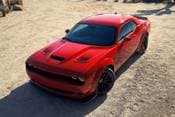 View 317 more photos
View 317 more photos View 317 more photos
View 317 more photos View 317 more photos
View 317 more photos+313
Edmunds' Expert Review
Pros
- Boffo V8 engine choices
- Roomy cabin can actually accommodate four adults
- High degree of customization thanks to many trim levels and options
- The ride is pretty comfortable compared to its muscle-car rivals
Cons
- Large and heavy with cumbersome handling
- Rear visibility is somewhat compromised
- Unlike main rivals, a convertible is not available
What's new
- The SRT 392 and limited-edition SRT Demon leave the lineup
- A new 797-hp SRT Hellcat Redeye model debuts
- Other Hellcat models get a new dual snorkel hood and a 10-hp increase
- The R/T Scat Pack Challenger is now available in Widebody form
- New Brass Monkey and Stars and Stripes appearance packages
- All-wheel drive is now available on the base SXT trim
- Part of the third Challenger generation introduced for 2008
There aren't a lot of vehicles we consider to be muscle cars. The 2019 Dodge Challenger, with its outlandish horsepower and classic styling, certainly qualifies. Muscle cars are also known for their lack of practicality, but the Challenger bucks that trend by making fewer sacrifices in everyday usability thanks to its large trunk and relatively spacious rear seats. Compared to the Chevrolet Camaro and the Ford Mustang, the Challenger is downright sensible.
For sale nationwide
945 listings
- $59,590good price$3,677 below market
- 26,683 miles
- 1 accident, 2 owners, personal use
- 8cyl automatic
- Carvana - Nashville (880 mi away)
- Home delivery*
- Back-up camera
- Bluetooth
- Navigation
- Leather Seats
- Keyless Entry/Start
Close
Located in Nashville, TN
At Carvana, we go miles beyond the extra mile. That's why we provide you with a convenient, fast, and hassle-free car buying experience that puts you ...
AutoCheck Vehicle History Summary
Accident Free Vehicle: No
Personal Use Only: Yes
History Provider: AutoCheck
Title Details: Clean Title
Salvage Vehicle: No
Frame Damage: No
Theft History: No
Lemon Status: No
Free History Report: No
Features and Specs:
16 Combined MPG (13 City/21 Highway)
Listing Information:
VIN: 2C3CDZC94KH613788
Stock: 2003723007
Certified Pre-Owned: No
Listed since: 05-23-2025 - $69,990good price$5,576 below market
- 3,450 miles
- No accidents, 1 owner, personal use only
- 8cyl automatic
- Carvana - Oklahoma City (731 mi away)
- Home delivery*
- Back-up camera
- Bluetooth
- Keyless Entry/Start
- Upgraded Headlights
- Power Driver Seat
Close
Located in Oklahoma City, OK
At Carvana, we go miles beyond the extra mile. That's why we provide you with a convenient, fast, and hassle-free car buying experience that puts you ...
AutoCheck Vehicle History Summary
Accident Free Vehicle: Yes
Personal Use Only: Yes
History Provider: AutoCheck
Title Details: Clean Title
Salvage Vehicle: No
Frame Damage: No
Theft History: No
Lemon Status: No
Free History Report: Yes
Features and Specs:
16 Combined MPG (13 City/21 Highway)
Listing Information:
VIN: 2C3CDZL95KH502442
Stock: 2003725223
Certified Pre-Owned: No
Listed since: 05-09-2025
This year, Dodge has retired the range-topping 840-horsepower Demon. To compensate, there's the new 797-hp SRT Hellcat Redeye. It's basically the Demon but with a slightly detuned V8 and less drag-race-specific hardware. There are also some changes in the supporting trims. All-wheel drive is now available on the base SXT, the Widebody treatment is offered on the R/T Scat Pack, and a new dual-snorkel hood increases Hellcat output by 10 hp. Some trims also come with fewer standard features and corresponding price drops.
Even without these latest changes, the Challenger would have remained one of our favorite vehicles in any class. It doesn't have the corner-carving chops of the Camaro or the Mustang, and we're quite fine with that. Not many cars have this kind of sinister style or performance that won't break the bank or overtly compromise your daily drive.
Edmunds' Expert Rating
7.8 / 10Performance is king among muscle cars and, unfortunately, it usually comes at the expense of practicality. But the 2019 Dodge Challenger defies convention. Its trunk and rear seats are far larger than the Ford Mustang's or Chevrolet Camaro's. You also get stylish and looks and mega amounts of power.
Trim tested
Each vehicle typically comes in multiple versions that are fundamentally similar. The ratings in this review are based on our full test of the Dodge Challenger Scat Pack Widebody (6.4L V8 | 6-speed manual | RWD).
 Scorecard
Scorecard
| Overall | 7.8 / 10 |
| Driving | 7.5 |
| Comfort | 7.5 |
| Interior | 7.5 |
| Utility | 8.0 |
| Technology | 8.0 |
Driving
7.5The Challenger may not be as fast or as responsive as the Mustang or Camaro, but it's always a hoot to drive. The Dodge's sheer size makes in-town maneuvering a bit tough (the widebody fenders don't help), but meaty tires and upgraded suspension help with handling and body roll.
Acceleration
7.5With the 6.4-liter V8, power is readily available in any gear at almost any speed. Zero to 60 mph took just 4.9 seconds at the Edmunds test track, which is properly quick but slower than other modern muscle cars by a few tenths. If you want more speed, there's always the 707-hp Hellcat.
Braking
8.0The brake pedal travel is a little long and a bit light at the top. But when you press into the stroke, the pedal feels confident and well-suited for everyday driving. During Edmunds testing, the Challenger came to a stop from 60 mph in 105 feet — a very short distance for such a big vehicle.
Steering
6.5The Challenger's steering feels hefty and reassuring while driving straight down the road, but it's a bit heavy for maneuvering around town. The wide tires from the widebody configuration worsen its bulkiness. Turn-in response happens quickly at speed, though there isn't much feedback communicated from the tires or road surface.
Handling
7.5Based on its sheer size (our Scat Pack widebody tester weighed in at 4,298 pounds), this is no sprightly sports car. But handling characteristics are surprisingly forgiving, and the grip limits are relatively high thanks to wide tires and the adaptive suspension that helps keep body roll in check.
Drivability
7.5Power delivery from the hulking 485-hp V8 is very smooth. Predictable clutch engagement and an easy-effort pedal mean smooth starts and gear changes with the six-speed manual. Responsive steering helps with highway maneuverability. But in the city, there is no avoiding this car's immense proportions.
Comfort
7.5Even when fitted with the Widebody package and stiffer adaptive suspension, the Challenger's highway ride quality is very good. Seat comfort is still near the top of the class. A relatively quiet cabin helps make it a nice place to be for extended periods.
Seat comfort
8.0The seat cushions are relatively flat and firm but comfortable enough for long road trips or commutes. Bolstering keeps you in place well enough around corners. The door and center armrests are nicely padded. The rear seats are genuinely adult-size and relatively comfortable, which is rare for the class.
Ride comfort
7.5The Challenger delivers a comfortable ride over small road imperfections but can feel pretty unsettled over larger cracks and potholes. The adaptive suspension helps increase handling limits but is still pretty stiff in its softest setting for everyday driving. The large 20-inch wheels and stiff tire sidewalls don't do it any favors either.
Noise & vibration
7.5The Challenger is normally one of the quietest cars in the class. But with the optional 6.4-liter V8 and extra-wide tires, there's a bit more road noise. The rumble from under the hood is also always there, but it turns into a deep, pleasant growl under full acceleration. There were no squeaks or rattles evident in our test car.
Climate control
7.5Dual-zone climate control is standard on the R/T and maintains the desired cabin temp well. Climate is controlled via the touchscreen or the knobs and buttons directly behind the shifter, making it somewhat hard to access. The seats heat well, but the ventilation could be more effective — and those controls are accessed exclusively in the touchscreen menus.
Interior
7.5The Challenger is king when it comes to passenger and cargo space. It's a far more livable daily driver than its crosstown competition. Wrestling the large, heavy doors open to gain access can be a challenge, however, and visibility suffers a bit like the rest.
Ease of use
8.5The controls consist of a combination of knobs and buttons that are large and easy to use. Some functions are tucked away in the touchscreen, but this interface is otherwise one of the easiest to use in the industry.
Getting in/getting out
7.0The doors are large and open fully, allowing the potential for easy entry and exit. That said, the big doors are heavy and their size is a hindrance in tighter parking spaces. The handles are also a bit difficult to get a grip on. Rear-seat access is average for a muscle car.
Driving position
7.0The Challenger is big everywhere, including the dashboard and seats. The driving position can be adjusted to fit most drivers, but it feels a bit cramped when you move your seat toward the dashboard for better forward visibility. The driver's seat has both power and manual adjustments, which is a bit cumbersome.
Roominess
8.0This cabin is the roomiest in the segment with lots of legroom and shoulder room up front. Headroom is a bit tight for taller passengers, but that's common for the class. The rear seat doesn't quite fit passengers of all sizes, but it is far bigger than that of competitors and offers three seats versus two. A family car!
Visibility
6.5Outward visibility is generally poor but typical for the segment. There are significant blind spots over both shoulders, and the windshield pillars obstruct forward sightlines more than your average vehicle. A large rearview camera display and a blind-spot monitor help considerably, but the rear camera resolution is very low.
Quality
7.0There were no squeaks or rattles to speak of in our test car, which felt like a well-built car. The interior design is a bit dated, however. The materials quality is decent for the Challenger's lower trim levels but gets harder to accept as you look at the more expensive models such as the R/T Scat Pack and Hellcat.
Utility
8.0While big American coupes aren't exactly perfect examples of utility, the Challenger easily leads the class throughout this category. You can legitimately fit children (or adults) in the back seat, and the trunk is massive compared to those of rivals.
Small-item storage
7.5There's decent small-item storage throughout the cabin, but the cupholders are right behind the gearshift, which is somewhat problematic with a manual transmission. The door pockets are small, with small bottle holders up front. In coupes this size, space is at a premium, but the Challenger uses what it has relatively well.
Cargo space
9.0The trunk opening is large, and its capacity blows the class away with a midsize sedan-like 16.2 cubic feet of cargo space. The Mustang's and Camaro's are a lot smaller. The rear seatbacks fold in a 60/40 split for extra utility.
Child safety seat accommodation
7.5The rear seat has three sets of lower LATCH anchors, so with the right seats you can fit the kids three-wide in the back. The anchors are buried a bit, and of course this is a two-door coupe, but this back seat is still far more versatile than those of the Challenger's direct rivals.
Technology
8.0With Apple CarPlay and Android Auto accompanying the Challenger's already easy-to-use Uconnect system, this plug-and-play system is one of the best out there. It's very easy to use with multiple solutions for the same commands. Compared to the class, however, the interface looks a bit dated.
Audio & navigation
8.0While the Uconnect system may look similar to older iterations, it's one of the most user-friendly systems in the class. The base six-speaker sound system has adequate sound quality but doesn't bump as hard as we'd like. Navigation instructions are clear, and inputting an address or point of interest is relatively simple.
Smartphone integration
8.0Uconnect is one of the easiest systems on the market to use, and it has aged well. Quick smartphone connection, easy-to-understand controls and simple command structures make for easy, distraction-free driving. And if you don't like the Uconnect, Apple CarPlay and Android Auto are standard.
Driver aids
7.5A rearview camera and rear parking sensors are standard. The Driver Convenience package adds blind-spot monitoring and rear cross-traffic alert. They worked well during our test without any false alerts.
Voice control
8.5The voice controls use a simple, easy-to-learn structure and take basic commands for the audio, navigation and hands-free calling. Connecting your smartphone makes things even more familiar.
Which Challenger does Edmunds recommend?
As far as we're concerned, the 2019 Dodge Challenger wouldn't be the same without a V8. That's why we recommend the R/T, which is the entry-level trim packing eight cylinders. Even better, you won't feel as if you're missing out on much since there's a long list of options. That means you can specify the R/T to meet your particular tastes and budget.
Compare 2019 Dodge Challenger trim levels
Helpful trims summary and side-by-side comparison chart
2019 Dodge Challenger models
The 2019 Dodge Challenger is a five-seat, two-door coupe that is available in seven major trim levels, most of which are further divided into several subtrims. Major trim levels include the SXT, GT, R/T, R/T 392, SRT Hellcat and SRT Hellcat Redeye. The SXT and the GT Challenger trims are powered by a V6. The others are driven by increasingly more powerful V8s, culminating in the 797-hp Redeye.
Dodge Challenger SXT
First up is the SXT, powered by a 3.6-liter V6 engine (305 horsepower, 268 pound-feet of torque) matched to an eight-speed automatic transmission. Standard features include 18-inch wheels, keyless ignition and entry, an auto-dimming rearview mirror, dual-zone automatic climate control, a leather-wrapped steering wheel, a power-adjustable driver seat and 60/40-split folding rear seats. Tech features include Bluetooth, a 7-inch touchscreen, a rearview camera, Apple CarPlay and Android Auto smartphone integration, two USB ports and a six-speaker sound system. The all-wheel-drive SXT upgrades to 19-inch wheels and upgraded brakes.
Dodge Challenger GT
The GT employs the same V6 and expands on the SXT's feature list with 20-inch wheels, the upgraded brakes, foglights, a hood scoop, rear parking sensors, remote ignition, a sport suspension, a performance steering system, more aggressively bolstered front seats, a sport steering wheel with shift buttons, and performance-related in-car apps. The all-wheel-drive GT reverts back to 19-inch wheels and loses the performance steering and sport suspension.
Dodge Challenger R/T
The R/T is the least expensive way into a V8 Challenger, offering a 5.7-liter engine paired to either a six-speed manual transmission (375 hp, 410 lb-ft) or the eight-speed auto (372 hp, 400 lb-ft). In addition to the GT features, you get different 20-inch wheels, a chrome fuel filler door, upgraded brakes, a limited-slip differential and an active sport exhaust.
Dodge Challenger R/T 392
The R/T 392 gets an even larger 6.4-liter V8 (485 hp, 475 lb-ft) along with launch control, a line lock for drag strip burnouts, Brembo performance brakes (four-piston front and rear), a higher-performance sport-tuned suspension, configurable driving modes, special styling elements, a black fuel door, a rear spoiler, heated cloth sport seats, a heated steering wheel, an 8.4-inch touchscreen with the newest version of Uconnect, a Wi-Fi hotspot, additional performance-related in-car apps, premium speakers, and HD and satellite radio.
There are also variants of the above, such as the Plus, R/T T/A, R/T Scat Pack and R/T Shaker that add a few extra features, special styling or performance enhancements. A new R/T Scat Pack 1320 has drag racers in mind, with numerous mechanical upgrades and weight reductions. The rear seats have been removed but can be added back for only $1.
Dodge Challenger SRT Hellcat
The SRT Hellcat is all about raw speed, evidenced by its supercharged 6.2-liter V8 (717 hp, 650 lb-ft). It's also equipped with unique exterior styling, a dual-snorkel hood, a sportier adaptive suspension, six-piston Brembo brakes, quad exhaust tips and interior ambient lighting. The R/T 392 and the Hellcat are eligible for the Widebody package that has fender flares to accommodate wider tires that improve the car's handling and grip.
Dodge Challenger SRT Hellcat Redeye
The new SRT Hellcat Redeye takes some inspiration from last year's Demon. The power output has been increased to ludicrous levels (797 hp, 707 lb-ft) and is only offered with an eight-speed automatic transmission.
Most of the features found on the upper trim levels can be added to the lower trims as options. Other add-ons include a sunroof, exterior stripes and graphics, xenon headlights, automatic high beams, automatic wipers, adaptive cruise control (automatic transmission only), forward collision warning, blind-spot monitoring and rear cross-traffic alert, ventilated seats, leather and/or faux suede upholstery, removal of the rear seat, a power tilt-and-telescoping steering wheel, a nine-speaker Alpine audio system, and an 18-speaker Harman Kardon premium surround-sound system.
A sunroof is optional on all Challenger trims, and new Hellcat buyers get a one-day course at an SRT Driving Experience school.
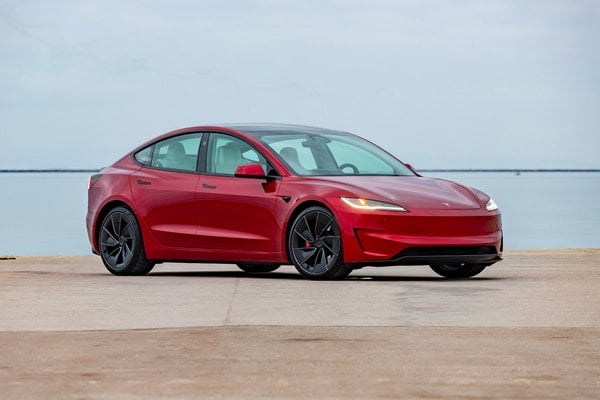
Our 2024 Tesla Model 3 Performance Is an Edmunds U-Drags Assassin
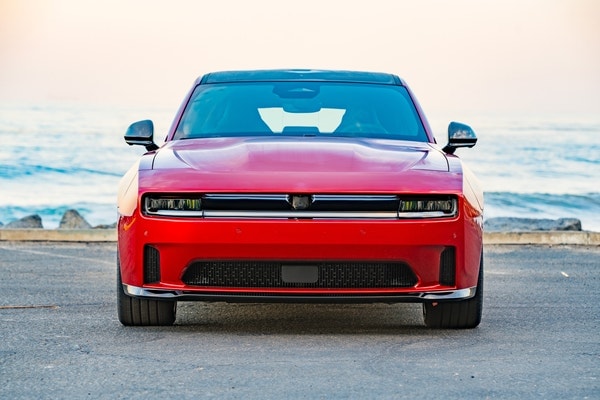
Here's What Really Happened With Our Dodge Charger EV's Unintended Acceleration
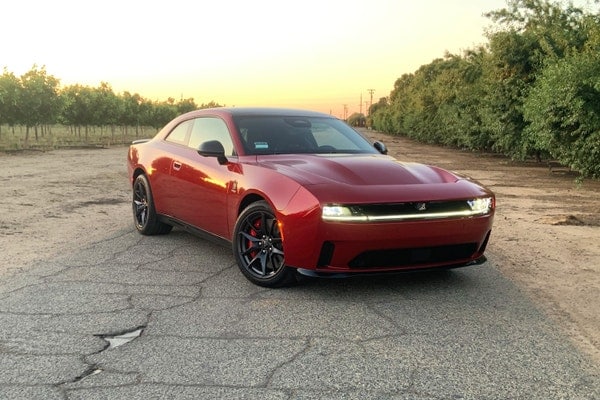
Yikes! Our Dodge Charger Daytona EV Had a Curious Case of Unintended Acceleration
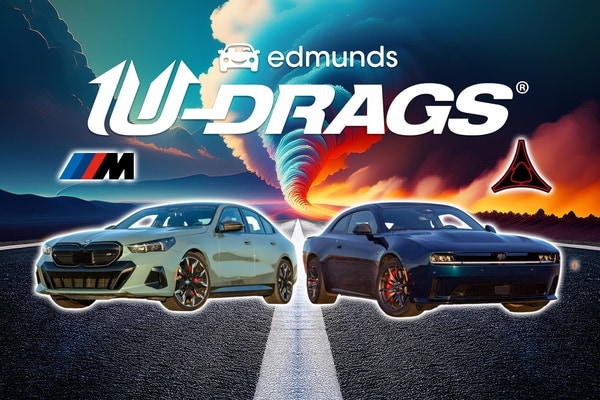
BMW i5 M60 vs. Dodge Charger Daytona: Big EVs Battle in Edmunds U-Drags
Cost to Drive
Monthly estimates based on costs in North Dakota
$166/mo for Challenger SXT
Challenger SXT
vs
$200/mo
Avg. Large Car
Reliability Ratings by RepairPal
3.5 out of 5 stars3.5/5Above Average
#25 out of 28 among Midsize Cars
RepairPal Reliability Ratings are based on the actual cost, frequency, and severity of unscheduled repairs and maintenance on make/model data for select 2008-2022 vehicles. The reliability of a specific vehicle may vary depending on its maintenance and driving history, model year, trim, and features.
Cost
$534/yr
vs. $415/yr
for Average Midsize Car
for Average Midsize Car
Frequency
0.83x/yr
vs. 0.87x/yr
for Average Midsize Car
for Average Midsize Car
Severity
16.4%
vs. 10.2%
for Average Midsize Car
for Average Midsize Car
powered by RepairPal
Dodge Challenger Owner Reviews
Most Helpful Owner Reviews
Trending topics
Dodge Challenger is everything.
5 out of 5 starsCrazyBilly, 12/31/2018
2019 Dodge Challenger R/T Scat Pack 2dr Coupe (6.4L 8cyl 6M)
Exceeds all expectations. Power to spare. Rides like a dream and accelerates like a champ!
First time challenger owner
5 out of 5 starsBrandon Schuld, 07/14/2019
2019 Dodge Challenger SXT 2dr Coupe (3.6L 6cyl 8A)
I was able to get out of an old junker Into a beautiful certified 2019 sxt challenger. People have made fun of me for saving some money and getting an sxt but, I really enjoy the ride the gas mileage (17.8 avg) for me is great. It's not loud at all unless u really punch it but I didn't buy it to race. Being a young parent too it's very roomy and very easy to put a car seat in unlike most … other muscle cars I was looking at. The entertainment features are overall good I like the size of the screen the Bluetooth is very smooth and easy to understand. One lacking feature I have to say is no nav at least on mine kinda is a let down considering there is a "compass" button like I really want my whole screen to be a silly compass. The speakers it comes with are very nice as a bass/sub enthusiast they sound very good from the start. The seats are comfy and have a cool design to them. Trunk space is really good too fits pretty much any kinda grocery bags or items within reason. I think on of my favorite thing about the car is the dash, the gauges look amazing! Whoever is in charge of the redesign they got on the interior a few years ago deserves a raise. Overall I'm very happy with my new car and in a few years I'll upgrade to the rt or scat pack but if your a young guy or girl lookin to get a challenger but can't afford the rt or scat pack there is no shame in the sxt it's a great vehicle, besides it's not like 23 year old me with a 1 year old is gonna be racing anyone around nj. Id recommend this vehicle to anyone.
In My Opinion Its The Best Bang For The Buck
5 out of 5 starsEric Kirshner, 02/16/2019
2019 Dodge Challenger R/T Scat Pack 2dr Coupe (6.4L 8cyl 6M)
I have owned a Mustang which was fun. I then followed the SUV/Crossover trend and owned SUVs for many years. I decided I wanted something fun and fast. I bought the Scat Pack Challenger. I had a few concerns like fuel mileage, insurance costs, and winter driving in the Chicago area. The gas mileage isn't spectacular but on the highway I can get high 20's. Insurance wasn't as bad as I … thought. My age has something to do with that I'm sure. If you're in your teens or 20's this isnt a cheap car to insure. As far as winter driving I decided to get winter tires. I actually have more confidence driving my Scat Pack in snow and ice with winter tires than any of the 4wd SUVs I have owned that had all season tires. This car is fast. Its fast enough that I have no desire to own a Hellcat. There is only so much speed you can use on the streets. I dont take my car to the track. If i did then maybe a Hellcat would make sense. Horsepower does change everything. When a car has this much power it's hard not to enjoy driving. Even if you thought your previous cars had sufficient acceleration this might change your mind. I have always wanted a Lamborghini or Ferrari since I was a kid. This car is faster than the Countach and the Testarossa cars I dreamed of having. It's just a slight bit slower than the Huracan or Hellcat 0-60, and maybe 1.5 -2 seconds slower in the quarter mile. Not bad considering this is a $45,000 car well equipped with Alcantara seats.
Running in the SNOW it was better than my JEEP!
4 out of 5 starsBeignet at the Beach, 04/29/2019
2019 Dodge Challenger GT 2dr Coupe AWD (3.6L 6cyl 8A)
I've driven several variants , and I really like the all wheel drive GT version with the 8 speed ZF automatic and the V6 pentastar engine. On the mountain twistys in VA & WVA it was outstanding . Quite a confidence builder for my long trip. A convertible version of this platform would be a MUST BUY for me. How about it FCA?
2019 Dodge Challenger videos
Muscle Car Debrief: Dodge Challenger Hellcat Redeye vs. Chevy Camaro ZL1 vs. Ford Mustang Shelby GT500
In this video, Carlos Lago, Elana Scherr and Kurt Niebuhr answer the most common questions about our muscle car drag race and comparison videos. Questions like, "Why didn't you use the Demon?" and "Why didn't you run on a prepared surface?" and "Why did a two-seat Mustang win a utility award?" and "Why are you all so bad at driving?"
2019 Challenger Highlights
Coupe
SXT
| Base MSRP Excludes Destination Fee | $27,845 |
|---|---|
| Engine Type | Gas |
| Combined MPG | 23 MPG |
| Cost to Drive | $166/month |
| Seating | 5 seats |
| Cargo Capacity All Seats In Place | 16.2 cu.ft. |
rear wheel drive | |
| Warranty | 3 years / 36,000 miles |
Safety
Our experts like the Challenger models:
- Blind-Spot Monitoring
- Illuminates a light on either of the Challenger's side mirrors when a vehicle enters its blind spot.
- Forward Collision Warning
- Helps prevent collisions by sounding an alert when the Challenger detects an imminent collision.
- Rear Cross-Traffic Alert
- Sounds a warning if a vehicle is approaching the Challenger from the side while it is backing into traffic.
NHTSA Overall Rating
5 out of 5 starsThe National Highway Transportation Safety Administration offers independent analysis.
- Frontal Barrier Crash RatingOverall4 / 5Driver4 / 5Passenger5 / 5
- Side Crash RatingOverall5 / 5
- Side Barrier RatingOverall5 / 5Driver5 / 5Passenger5 / 5
- Combined Side Barrier & Pole RatingsFront Seat5 / 5Back Seat5 / 5
- RolloverRollover4 / 5Dynamic Test ResultNo TipRisk Of Rollover11.1%
IIHS Rating
The Insurance Institute of Highway Safety uses extensive crash tests to determine car safety.
- Small Overlap Front Driver-Side TestMarginal
- Small Overlap Front Passenger-Side TestNot Tested
- Moderate Overlap Front Test – OriginalGood
- Moderate Overlap Front Test – UpdatedNot Tested
- Side Impact Test – OriginalGood
- Side Impact Test – UpdatedNot Tested
- Roof Strength TestAcceptable
- Rear Crash Protection / Head RestraintAcceptable
People who viewed this also viewed
| 5.0 average Rating out of 8 reviews. |
| Starting at $30,900 |
| 5.0 average Rating out of 9 reviews. |
| Starting at $34,295 |
| 4.0 average Rating out of 1 reviews. |
| Starting at $158,600 |
Related Used 2019 Dodge Challenger info
Vehicle reviews of used models
- Porsche Cayenne Coupe 2021 Review
- Porsche Cayenne 2021 Review
- Jeep Grand Cherokee L 2021 Review
- Ram Promaster Cargo Van 2020 Review
- Buick Enclave 2020 Review
Shop similar models
Shop used vehicles in your area
- Used Dodge Challenger 2010
- Used Dodge Challenger 2011
- Used Dodge Challenger 2012
- Used Dodge Challenger 2013
- Used Dodge Challenger 2014
- Used Dodge Challenger 2015
- Used Dodge Challenger 2016
- Used Dodge Challenger 2017
- Used Dodge Challenger 2018
- Used Dodge Challenger 2019
Popular new car reviews and ratings
- 2025 Aston Martin Vantage
- Audi A3 2024
- New Land Rover Discovery Sport
- 2024 F-PACE
- 2024 MINI Cooper
- New Cadillac CT5
- 2024 Sierra 3500HD
- New Chevrolet Silverado 1500
- 2024 Mercedes-Benz GLC Coupe
- Cadillac Escalade ESV 2025
Research other models of Dodge
- New Dodge Hornet
- Dodge Charger 2024
- 2025 Dodge Durango
- Dodge Durango 2024
- 2024 Durango
- New Dodge Durango
- 2024 Dodge Durango
Research similar vehicles
Other models
- New Jeep Wrangler-4Xe for Sale in Port Angeles, WA
- Used Lexus GS-300 in Fort Bragg, NC 2019
- Used Volkswagen Beetle-Convertible in Oak Creek, WI 2019
- Used Infiniti Q60-Coupe in Clover, SC 2015
- New Mercedes-Benz E-Class for Sale in Morgan Hill, CA
- Used Buick Century in Walla Walla, WA 2005
- Used Toyota Tacoma in Newton, NJ 2025
- Used Isuzu Trooper in Mays Landing, NJ 2002
- Used Audi Q3 in Lewis Center, OH 2025
- Used Lincoln Aviator in Lansdale, PA 2025


